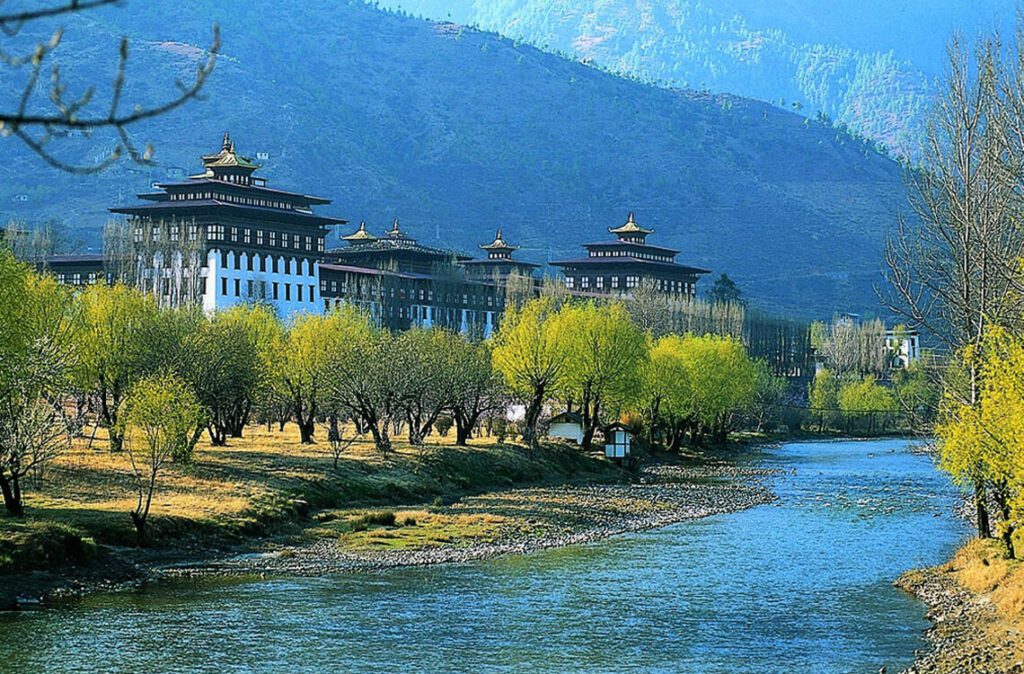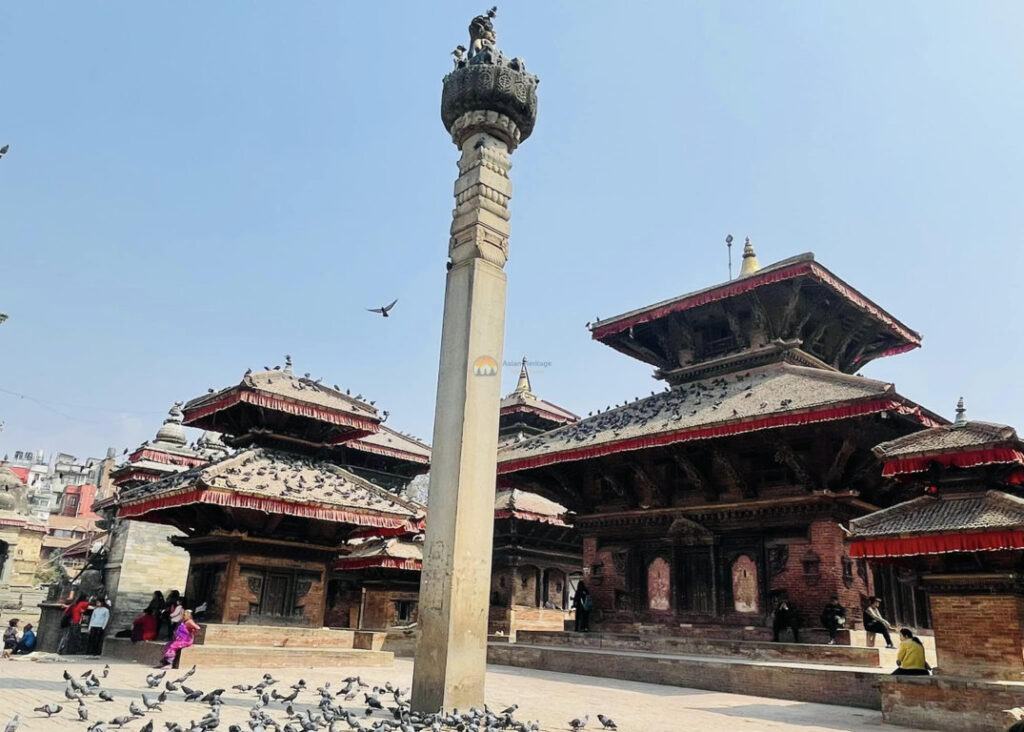Bhutan Trip from Nepal Cost- If you are looking for a unique travel experience that takes you on a journey to discover the cultural and natural wonders of the Himalayas, a Bhutan trip from Kathmandu is the perfect adventure for you.
Nestled between India and Tibet, Bhutan is a small kingdom that has managed to preserve its traditional way of life, untouched by the modern world. Known as the ‘Land of the Thunder Dragon,’ Bhutan is a destination that offers a rare opportunity to experience a world that is still deeply rooted in ancient traditions and beliefs.

The journey begins in Kathmandu, the capital city of Nepal where you will be able to witness the stunning blend of traditional and modern cultures. The bustling streets of Kathmandu are a hub of activity, filled with the sights, sounds, and smells of a city that has a rich history and culture.
Getting to Bhutan from Nepal
Bhutan Trip from Nepal Cost- If you’re planning a trip to Bhutan from Nepal, there are a few options for getting there. The easiest and most convenient way is by air. Bhutan’s national carrier Druk Air operates flights between Kathmandu, Nepal, and Paro Bhutan’s only international airport. The flight takes about an hour and offers stunning views of the Himalayas.

Druk Air operates flights between Kathmandu and Paro twice a week on Mondays and Thursdays. However, keep in mind that flight schedules can change due to weather conditions so it’s always best to check with the airline before booking your trip.
If you prefer to travel overland, you can take a bus or drive from Nepal to the border town of Phuentsholing and then cross the border into Bhutan. The journey can take several hours and the roads can be rough and winding so it’s best to be prepared for a long journey. Once you reach Phuentsholing you will need to obtain a Bhutanese visa and permit before you can continue your journey into Bhutan.
Also Read: Buddhists Holiest Festival: Mani Rimdu Festival
It’s worth noting that Bhutan’s visa and permit system is designed to promote sustainable tourism and ensure that visitors respect the country’s unique culture and environment. All tourists visiting Bhutan are required to book their trip through a licensed Bhutanese tour operator who will handle the visa and permit process for you. The cost of the visa and permit is included in your tour package.
How to Get Bhutan Visa from Nepal
Bhutan Trip from Nepal Cost- To get a Bhutan visa from Nepal, you will need to follow a few important steps. Firstly, you should contact a licensed Bhutanese tour operator and provide them with your passport details, a passport-size photograph, and a Bhutan visa application form. The tour operator will then provide you with a tour package cost which you will need to pay in full.

Once they receive your payment they will apply for a Bhutan visa on your behalf with the Bhutanese government. After your Bhutan visa application is approved, you will receive a visa clearance letter from the tour operator. When you arrive at the Paro International Airport in Bhutan, you will need to show your visa clearance letter to the immigration officer who will then issue your actual Bhutan visa. It costs $40 per person.
When to Visit Bhutan From Nepal?
Bhutan Trip from Nepal Cost- Bhutan is a lovely nation with a rich cultural history and breathtaking scenery. It is located to the east of Nepal and has borders with India and China. It is a hilly nation with peaks varying in elevation from 1,500 to more than 7,000 meters above sea level. The ideal months to visit Bhutan from Kathmandu are March to May and September to November. Bhutan’s weather is quite warm throughout these months, with a bright sky and a comfortable temperature. During the day, the temperature fluctuates between 20 and 25 degrees Celsius dropping to roughly 10 degrees at night.

During these months, the natural scenery of Bhutan is at its best, with blooming rhododendrons, cherry blossoms, and wildflowers painting the valleys and hillsides with colors. Also, the monsoon season is over and the skies are generally clear making it easier to enjoy the beautiful landscapes and outdoor activities.
How Much Does it Cost?
The cost range of a trip from Kathmandu to Bhutan can vary depending on the duration of the trip, mode of transportation, type of accommodation, activities planned, and the time of year. For a typical 5-day trip, the cost range can be estimated as follows: the visa and tour cost is a minimum of $250 per person per day during peak season (March, April, May, September, October, and November) and $200 per person per day during off-peak season (December, January, February, June, July, and August) which includes all accommodation, meals, transportation, and sightseeing activities. The total tour cost can range from $1000 to $1250 per person.

The round-trip airfare from Kathmandu to Paro can cost anywhere from $250 to $500 per person, depending on the time of year and how early you book. The tour package includes accommodation in 3-star hotels, but upgrading to 4-star or 5-star hotels can incur an additional cost of $100 to $200 per night. It includes transportation within Bhutan, but choosing a private car may result in an additional charge of $50 to $100 per day. Although meals may be part of the package, dining at local restaurants or cafes can vary in cost, typically ranging from $10 to $20 per person. Additionally, the expense of alcohol tends to be high due to substantial taxes.
The highlight of the Trip
Bhutan Trip from Nepal Cost- If you are traveling from Kathmandu, Nepal to Bhutan, there are several highlights you should look forward to and some of them are:
You may also like: Bhutan tour packages from Nepal
Paro Valley and Tiger’s Nest Monastery:
The Paro Valley is one of the most beautiful valleys in Bhutan which is surrounded by lush green mountains and dotted with traditional Bhutanese houses.

The valley is also home to the iconic Tiger’s Nest Monastery which rests on a cliff more than 3,000 meters above sea level. The hike to the monastery takes about three hours and is a challenging yet rewarding experience.
Thimphu:
Thimphu is the capital city of Bhutan and a great place to experience the country’s unique culture. The city has a mix of traditional Bhutanese architecture and modern buildings. You can visit the Tashichho Dzong, the seat of the Bhutanese government and the King’s office, and the National Memorial Chorten, a stupa built in memory of the third king of Bhutan.

Punakha Dzong:
One of Bhutan’s most significant and stunning dzongs is Punakha Dzong. Established in 1637, it functioned as the capital until 1955. Located at the confluence of two rivers and enveloped by verdant hills, the dzong boasts of housing some of the Bhutanese Buddhist tradition’s most significant relics.
Dochula Pass:
Dochula Pass is a mountain pass located on the way from Thimphu to Punakha. Known for its panoramic views of the Himalayas, the site features 108 Chortens (Buddhist shrines) built to commemorate Bhutanese soldiers who lost their lives in a 2003 conflict with insurgents from India.
Popular: Upper Mustang Festival: An Spiritual Heaven
Bhutanese cuisine:
Bhutanese cuisine is a unique blend of spicy and savory flavors. The national dish is Ema Datshi which is made with cheese and chili peppers. Other popular dishes include momos, paksha paa, and Jasha maru.
Tips for Trip
Here are some of the tips to make your trip convenient and trouble-free:
Obtain a Bhutanese Visa:
It’s important to plan well in advance and obtain your Bhutanese visa before you leave Kathmandu as you will not be able to obtain a visa upon arrival in Bhutan. By following the above-mentioned steps and working with a licensed tour operator, you can ensure a smooth and hassle-free visa application process for your trip to Bhutan.
Be prepared for the altitude:
Bhutan is a mountainous country that is located in the eastern Himalayas, with elevations ranging from 97 meters in the south to over 7,500 meters in the north. Many of the popular tourist destinations in Bhutan such as Paro and Thimphu are located at elevations above 2,000 meters which can cause altitude sickness in some travelers.

Reduced air pressure and lower oxygen levels at high altitudes cause altitude sickness, also known as acute mountain sickness. Symptoms of AMS include headache, nausea, dizziness, fatigue, and shortness of breath. In severe cases, it can lead to more serious conditions such as high-altitude pulmonary edema and high-altitude cerebral edema. If you’re concerned about altitude sickness then it’s a good idea to speak with your doctor before your trip.
They may be able to prescribe medication such as acetazolamide to help prevent AMS. It’s also important to listen to your body and take breaks as needed. If you experience severe symptoms of AMS it’s important to seek medical attention immediately.
Plan your Itinerary:
When embarking on a trek from Kathmandu to Bhutan planning your itinerary is an essential aspect of ensuring a successful and enjoyable journey. This involves mapping out your trekking route and schedule in advance, taking into consideration the distance, terrain, and any potential obstacles or challenges you may encounter along the way.

It’s important to allow for sufficient time to complete the trek, as rushing through it can lead to exhaustion and increase the risk of injury. Additionally, taking the time to enjoy the sights and experience the local culture can greatly enhance the overall trekking experience.
Stay Hydrated:
Staying hydrated is crucial when embarking on a trek from Kathmandu to Bhutan. Hiking at high altitudes during the trek can result in dehydration and altitude sickness if you do not maintain proper hydration.
More: What are Prayer Flags?
To avoid these risks, it’s important to drink plenty of water throughout the trek. Carrying a reusable water bottle and refilling it whenever you get the chance is a good way to ensure that you always have access to clean drinking water.
Hire a guide:
When planning a trek from Kathmandu to Bhutan, it highly recommends hiring a guide for the journey. A guide can provide numerous benefits to help make your trek both safer and more enjoyable. One of the primary benefits of hiring a guide is that they can provide valuable information about the trek such as the best routes to take, local customs and cultures, and other tips and tricks to make the journey more comfortable and fulfilling. In addition to providing information, a guide can also assist with permits and logistics. Bhutan requires all trekkers to obtain permits, which can be a complex and time-consuming process.
Let our expert team at Asian Heritage Treks and Travel take care of everything — from guided tours to personalized packing tips and travel arrangements.
Plan My Nepal Trip







